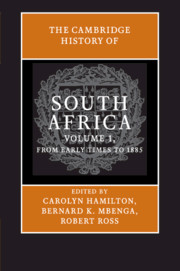Book contents
- Frontmatter
- 1 The Production of Preindustrial South African History
- 2 The Appearance of Food Production in Southern Africa 1,000 to 2,000 Years Ago
- 3 Farming Communities of the Second Millennium: Internal Frontiers, Identity, Continuity and Change
- 4 Khoesan and Immigrants: The Emergence of Colonial Society in the Cape, 1500–1800
- 5 Turbulent Times: Political Transformations in the North and East, 1760s–1830s
- 6 From Slave Economy to Settler Capitalism: The Cape Colony and Its Extensions, 1800–1854
- 7 From Colonial Hegemonies to Imperial Conquest, 1840–1880
- 8 Transformations in Consciousness
- Index
- References
2 - The Appearance of Food Production in Southern Africa 1,000 to 2,000 Years Ago
Published online by Cambridge University Press: 28 September 2010
- Frontmatter
- 1 The Production of Preindustrial South African History
- 2 The Appearance of Food Production in Southern Africa 1,000 to 2,000 Years Ago
- 3 Farming Communities of the Second Millennium: Internal Frontiers, Identity, Continuity and Change
- 4 Khoesan and Immigrants: The Emergence of Colonial Society in the Cape, 1500–1800
- 5 Turbulent Times: Political Transformations in the North and East, 1760s–1830s
- 6 From Slave Economy to Settler Capitalism: The Cape Colony and Its Extensions, 1800–1854
- 7 From Colonial Hegemonies to Imperial Conquest, 1840–1880
- 8 Transformations in Consciousness
- Index
- References
Summary
About 2,000 years ago domestic animals, first sheep and later cattle, and domestic plants, principally sorghum and millet, spread to Southern Africa from areas to the north where they were originally domesticated some thousands of years earlier. The retrieval of the remains of these domesticates has allowed archaeologists to develop narratives that describe the social events responsible for the material traces excavated. For historical reasons these events are referred to as “stone age” in the West or “iron age” in the East, depending on the absence or presence of traces of iron use and smelting as associated practices. There is a broad correspondence between this distinction and between the winter (and year-round) and summer rainfall zones of Southern Africa. Here we address the geographic and historical contexts under which people adopted some or other mix of domestic plants and animals, transforming hunter–gatherers into either farmers or herders. We follow Mitchell and others in using the term herder for the (economic) practice of keeping domestic stock and pastoralist and farmer for the (cognitive) practice of developing a world view around mobile stock ownership and sedentary mixed agriculture, respectively.
THE NATURE OF ARCHAEOLOGY AS HISTORY
To explain the appearance of food production in Southern Africa, to document the arrival of domestic plants and animals, and to understand the addition of food production alongside hunting and gathering in certain areas and the replacement of hunting and gathering in others, it is necessary to establish in broad outline the nature of archaeology as history and the comparative relationship between the two.
- Type
- Chapter
- Information
- The Cambridge History of South Africa , pp. 63 - 111Publisher: Cambridge University PressPrint publication year: 2009
References
- 1
- Cited by



